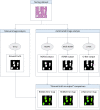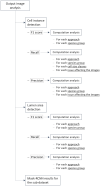Mask, Train, Repeat! Artificial Intelligence for Quantitative Wood Anatomy
- PMID: 34804101
- PMCID: PMC8601631
- DOI: 10.3389/fpls.2021.767400
Mask, Train, Repeat! Artificial Intelligence for Quantitative Wood Anatomy
Abstract
The recent developments in artificial intelligence have the potential to facilitate new research methods in ecology. Especially Deep Convolutional Neural Networks (DCNNs) have been shown to outperform other approaches in automatic image analyses. Here we apply a DCNN to facilitate quantitative wood anatomical (QWA) analyses, where the main challenges reside in the detection of a high number of cells, in the intrinsic variability of wood anatomical features, and in the sample quality. To properly classify and interpret features within the images, DCNNs need to undergo a training stage. We performed the training with images from transversal wood anatomical sections, together with manually created optimal outputs of the target cell areas. The target species included an example for the most common wood anatomical structures: four conifer species; a diffuse-porous species, black alder (Alnus glutinosa L.); a diffuse to semi-diffuse-porous species, European beech (Fagus sylvatica L.); and a ring-porous species, sessile oak (Quercus petraea Liebl.). The DCNN was created in Python with Pytorch, and relies on a Mask-RCNN architecture. The developed algorithm detects and segments cells, and provides information on the measurement accuracy. To evaluate the performance of this tool we compared our Mask-RCNN outputs with U-Net, a model architecture employed in a similar study, and with ROXAS, a program based on traditional image analysis techniques. First, we evaluated how many target cells were correctly recognized. Next, we assessed the cell measurement accuracy by evaluating the number of pixels that were correctly assigned to each target cell. Overall, the "learning process" defining artificial intelligence plays a key role in overcoming the issues that are usually manually solved in QWA analyses. Mask-RCNN is the model that better detects which are the features characterizing a target cell when these issues occur. In general, U-Net did not attain the other algorithms' performance, while ROXAS performed best for conifers, and Mask-RCNN showed the highest accuracy in detecting target cells and segmenting lumen areas of angiosperms. Our research demonstrates that future software tools for QWA analyses would greatly benefit from using DCNNs, saving time during the analysis phase, and providing a flexible approach that allows model retraining.
Keywords: F1 score; ROXAS; artificial intelligence; deep learning; lumen area; wood anatomy.
Copyright © 2021 Resente, Gillert, Trouillier, Anadon-Rosell, Peters, von Arx, von Lukas and Wilmking.
Conflict of interest statement
The authors declare that the research was conducted in the absence of any commercial or financial relationships that could be construed as a potential conflict of interest. The reviewer AB declared a past collaboration with one of the authors MW to the handling editor.
Figures








Similar articles
-
Towards ROXAS AI: automatic multi-species ring boundaries segmentation as regression in anatomical images.Front Plant Sci. 2025 May 6;16:1516635. doi: 10.3389/fpls.2025.1516635. eCollection 2025. Front Plant Sci. 2025. PMID: 40395279 Free PMC article.
-
Contrasting distribution and seasonal dynamics of carbohydrate reserves in stem wood of adult ring-porous sessile oak and diffuse-porous beech trees.Tree Physiol. 2002 Dec;22(17):1201-10. doi: 10.1093/treephys/22.17.1201. Tree Physiol. 2002. PMID: 12464573
-
Use of X-ray computed microtomography for non-invasive determination of wood anatomical characteristics.J Struct Biol. 2004 Oct;148(1):11-21. doi: 10.1016/j.jsb.2004.05.001. J Struct Biol. 2004. PMID: 15363784
-
Comparing the intra-annual wood formation of three European species (Fagus sylvatica, Quercus petraea and Pinus sylvestris) as related to leaf phenology and non-structural carbohydrate dynamics.Tree Physiol. 2012 Aug;32(8):1033-45. doi: 10.1093/treephys/tps052. Epub 2012 Jun 20. Tree Physiol. 2012. PMID: 22718524
-
Flash-flood impacts cause changes in wood anatomy of Alnus glutinosa, Fraxinus angustifolia and Quercus pyrenaica.Tree Physiol. 2010 Jun;30(6):773-81. doi: 10.1093/treephys/tpq031. Epub 2010 May 12. Tree Physiol. 2010. PMID: 20462937
Cited by
-
Enabling high-throughput quantitative wood anatomy through a dedicated pipeline.Plant Methods. 2025 Feb 4;21(1):11. doi: 10.1186/s13007-025-01330-7. Plant Methods. 2025. PMID: 39905535 Free PMC article.
-
A protocol for high-quality sectioning for tree-ring anatomy.Front Plant Sci. 2025 Feb 26;16:1505389. doi: 10.3389/fpls.2025.1505389. eCollection 2025. Front Plant Sci. 2025. PMID: 40093603 Free PMC article.
-
Towards ROXAS AI: automatic multi-species ring boundaries segmentation as regression in anatomical images.Front Plant Sci. 2025 May 6;16:1516635. doi: 10.3389/fpls.2025.1516635. eCollection 2025. Front Plant Sci. 2025. PMID: 40395279 Free PMC article.
-
Tree ring segmentation using UNEt TRansformer neural network on stained microsections for quantitative wood anatomy.Front Plant Sci. 2024 Jan 8;14:1327163. doi: 10.3389/fpls.2023.1327163. eCollection 2023. Front Plant Sci. 2024. PMID: 38259935 Free PMC article.
References
-
- Björklund J., Seftigen K., Fonti P., Nievergelt D., von Arx G. (2020). Dendroclimatic potential of dendroanatomy in temperature-sensitive Pinus sylvestris. Dendrochronologia 60:125673. 10.1016/j.dendro.2020.125673 - DOI
-
- Christin S., Hervet É, Lecomte N. (2019). Applications for deep learning in ecology. Methods Ecol. Evol. 10 1632–1644. 10.1111/2041-210X.13256 - DOI
-
- De Micco V., Carrer M., Rathgeber C. B., Julio Camarero J., Voltas J., Cherubini P., et al. (2019). From xylogenesis to tree rings: wood traits to investigate tree response to environmental changes. IAWA J. 40 155–182. 10.1163/22941932-40190246 - DOI
LinkOut - more resources
Full Text Sources

